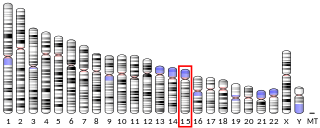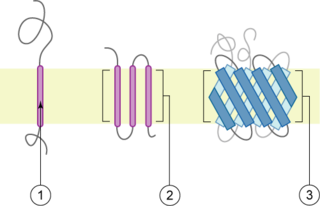Related Research Articles
The solute carrier (SLC) group of membrane transport proteins include over 400 members organized into 66 families. Most members of the SLC group are located in the cell membrane. The SLC gene nomenclature system was originally proposed by the HUGO Gene Nomenclature Committee (HGNC) and is the basis for the official HGNC names of the genes that encode these transporters. A more general transmembrane transporter classification can be found in TCDB database.

Neutral and basic amino acid transport protein rBAT is a protein that in humans is encoded by the SLC3A1 gene.

Solute carrier organic anion transporter family member 1B1 is a protein that in humans is encoded by the SLCO1B1 gene. Pharmacogenomic research indicates that genetic variations in this gene are associated with response to simvastatin. Clinical guidelines exist that can guide dosing of simvastatin based on SLCO1B1 gene variant using genotyping or whole exome sequencing.

Ileal sodium/bile acid cotransporter, also known as apical sodium–bile acid transporter (ASBT) and ileal bile acid transporter (IBAT), is a bile acid:sodium symporter protein that in humans is encoded by the SLC10A2 gene.

Solute carrier family 22 member 11 is a protein that in humans is encoded by the SLC22A11 gene.

Large neutral amino acids transporter small subunit 2 is a protein that in humans is encoded by the SLC7A8 gene.

Solute carrier organic anion transporter family member 1B3 (SLCO1B3) also known as organic anion-transporting polypeptide 1B3 (OATP1B3) is a protein that in humans is encoded by the SLCO1B3 gene.

Sodium/bile acid cotransporter also known as the Na+-taurocholate cotransporting polypeptide (NTCP) or liver bile acid transporter (LBAT) is a protein that in humans is encoded by the SLC10A1 (solute carrier family 10 member 1) gene.
An amino acid transporter is a membrane transport protein that transports amino acids. They are mainly of the solute carrier family.

Solute carrier organic anion transporter family member 1A2 is a protein that in humans is encoded by the SLCO1A2 gene.

Organic solute transporter alpha, also known as OST-alpha, is a protein which in humans is encoded by the SLC51A gene.

Solute carrier family 22 member 7 is a protein that in humans is encoded by the gene SLC22A7.

Solute carrier family 22 member 9 is a protein that in humans is encoded by the SLC22A9 gene.

Organic solute transporter beta, also known as OST-beta, is a protein which in humans is encoded by the OSTB gene.

The organic anion transporter 1 (OAT1) also known as solute carrier family 22 member 6 (SLC22A6) is a protein that in humans is encoded by the SLC22A6 gene. It is a member of the organic anion transporter (OAT) family of proteins. OAT1 is a transmembrane protein that is expressed in the brain, the placenta, the eyes, smooth muscles, and the basolateral membrane of proximal tubular cells of the kidneys. It plays a central role in renal organic anion transport. Along with OAT3, OAT1 mediates the uptake of a wide range of relatively small and hydrophilic organic anions from plasma into the cytoplasm of the proximal tubular cells of the kidneys. From there, these substrates are transported into the lumen of the nephrons of the kidneys for excretion. OAT1 homologs have been identified in rats, mice, rabbits, pigs, flounders, and nematodes.

Monocarboxylate transporter 10, also known as aromatic amino acid transporter 1 and T-type amino acid transporter 1 (TAT1) and solute carrier family 16 member 10 (SLC16A10), is a protein that in humans is encoded by the SLC16A10 gene. SLC16A10 is a member of the solute carrier family.

Solute carrier family 17, member 3 is a protein that in humans is encoded by the SLC17A3 gene.
This family of proteins are found both in prokaryotes and eukaryotes. In mammals, they are transmembrane proteins with functions in the liver and in the intestine. They are members of the solute carrier family of cotransporter genes which include SLC10A1 and SLC10A2.
The anion exchanger family is a member of the large APC superfamily of secondary carriers. Members of the AE family are generally responsible for the transport of anions across cellular barriers, although their functions may vary. All of them exchange bicarbonate. Characterized protein members of the AE family are found in plants, animals, insects and yeast. Uncharacterized AE homologues may be present in bacteria. Animal AE proteins consist of homodimeric complexes of integral membrane proteins that vary in size from about 900 amino acyl residues to about 1250 residues. Their N-terminal hydrophilic domains may interact with cytoskeletal proteins and therefore play a cell structural role. Some of the currently characterized members of the AE family can be found in the Transporter Classification Database.
Members of the Organo Anion Transporter (OAT) Family are membrane transport proteins or 'transporters' that mediate the transport of mainly organic anions across the cell membrane. Therefore, OATPs are present in the lipid bilayer of the cell membrane, acting as the cell's gatekeepers. OATPs belong to the Solute Carrier Family (SLC) and the major facilitator superfamily.
References
- ↑ Wang, W; Seward, DJ; Li, L; Boyer, JL; Ballatori, N (July 31, 2001). "Expression cloning of two genes that together mediate organic solute and steroid transport in the liver of a marine vertebrate". Proceedings of the National Academy of Sciences USA. 98 (16): 9431–6. Bibcode:2001PNAS...98.9431W. doi: 10.1073/pnas.161099898 . PMC 55438 . PMID 11470901.
- ↑ Seward, DJ; Koh, AS; Boyer, JL; Ballatori, N (July 25, 2003). "Functional complementation between a novel mammalian polygenic transport complex and an evolutionarily ancient organic solute transporter, OSTalpha-OSTbeta". Journal of Biological Chemistry. 278 (30): 27473–82. doi: 10.1074/jbc.M301106200 . PMID 12719432.
- 1 2 3 Saier, Milton. "Transporter Classification Database: 2.A.82 The Organic Solute Transporter (OST) Family". tcdb.org.
- ↑ Ballatori, Nazzareno; Christian, Whitney V.; Wheeler, Sadie G.; Hammond, Christine L. (2013-04-01). "The heteromeric organic solute transporter, OSTα–OSTβ/SLC51: A transporter for steroid-derived molecules". Molecular Aspects of Medicine. The ABCs of membrane transporters in health and disease (SLC series). 34 (2–3): 683–692. doi:10.1016/j.mam.2012.11.005. PMC 3827772 . PMID 23506901.
- ↑ Dawson, Paul A.; Hubbert, Melissa; Haywood, Jamie; Craddock, Ann L.; Zerangue, Noa; Christian, Whitney V.; Ballatori, Nazzareno (2005-02-25). "The heteromeric organic solute transporter alpha-beta, Ostalpha-Ostbeta, is an ileal basolateral bile acid transporter". The Journal of Biological Chemistry. 280 (8): 6960–6968. doi: 10.1074/jbc.M412752200 . ISSN 0021-9258. PMC 1224727 . PMID 15563450.
- ↑ Christian, WV; Li, N; Hinkle, PM; Ballatori, N (June 15, 2012). "β-Subunit of the Ostα-Ostβ organic solute transporter is required not only for heterodimerization and trafficking but also for function". Journal of Biological Chemistry. 287 (25): 21233–43. doi: 10.1074/jbc.M112.352245 . PMC 3375545 . PMID 22535958.
- ↑ Dawson, PA; Hubbert, M; Haywood, J; Craddock, AL; Zerangue, N; Christian, WV; Ballatori, N (Feb 25, 2005). "The heteromeric organic solute transporter alpha-beta, Ostalpha-Ostbeta, is an ileal basolateral bile acid transporter". J Biol Chem. 280 (8): 6960–8. doi: 10.1074/jbc.M412752200 . PMC 1224727 . PMID 15563450.
- ↑ Dawson, PA; Hubbert, ML; Rao, A (September 2010). "Getting the mOST from OST: Role of organic solute transporter, OSTalpha-OSTbeta, in bile acid and steroid metabolism". Biochim Biophys Acta. 1801 (9): 994–1004. doi:10.1016/j.bbalip.2010.06.002. PMC 2911127 . PMID 20538072.
- ↑ Roth B., M; Obaidat, A; Hagenbuch, B (March 2012). "OATPs, OATs and OCTs: the organic anion and cation transporters of the SLCO and SLC22A gene superfamilies". British Journal of Pharmacology. 165 (5): 1260–87. doi:10.1111/j.1476-5381.2011.01724.x. PMC 3372714 . PMID 22013971.